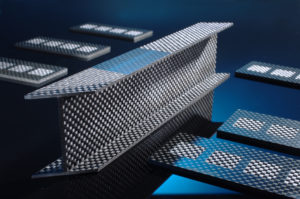 Composite materials made of glass or carbon fibers are characterized by their low specific weight and outstanding mechanical characteristics. Fiber-reinforced components are already being successfully processed today in industrial mass production. Although the material does have limitations regarding the manufacturing processes that can be used, these can be overcome through the clever use of laser processes. Having been prevalent in the aerospace industry for many years, fiber-reinforced materials are now being successfully used in numerous other sectors such as automotive construction, medical engineering, and building construction. As a result, the demand for materials and processing methods is also growing fast.
Composite materials made of glass or carbon fibers are characterized by their low specific weight and outstanding mechanical characteristics. Fiber-reinforced components are already being successfully processed today in industrial mass production. Although the material does have limitations regarding the manufacturing processes that can be used, these can be overcome through the clever use of laser processes. Having been prevalent in the aerospace industry for many years, fiber-reinforced materials are now being successfully used in numerous other sectors such as automotive construction, medical engineering, and building construction. As a result, the demand for materials and processing methods is also growing fast.
The high-quality mechanical characteristics of fiber-reinforced components stem from a load-adapted composition of polymermatrix and fibers. In order to remove the matrix material close to the surface, the Fraunhofer Institute for Laser Technology ILT developed a method that allows the outer layers of the surrounding polymer matrix to be removed without damaging the underlying fibers.
Exposing carbon-fiber components
Using ultrashort pulsed laser radiation, the matrixmaterial– which usually consists of epoxy resin – can be processed with local and depth-selective ablation and can even be removed completely. An adapted process control allows the surface to be processed in such a way that the adjacent fibers do not suffer any damage. «This is achieved through a local and selective adjustment of laser power and beam guidance» explains Christian Hördemann, scientist at Fraunhofer ILT. As a result, even complex geometries and 3D components can be processed with the laser. «This ability to process surfaces without disturbing the load-oriented processed fibers is especially interesting for the aerospace industry. »
Joining heterogeneous components and metalizing plastic components using environmental friendly methods
A possible field of application for the new method is in preparing a solid joint between composite materials and adjacent components. In a subsequent step, heterogeneous plastics can be sprayed directly onto the exposed fiber structure, whereby they surround the fibers and can be mated in a form-closed joint. Moreover, the method is also suitable for subsequent work steps using adhesion. For certain applications, CFRP and other plastic components must be coated with conductive layers. Working together with Fraunhofer IST, Fraunhofer ILT developed the method so that plastic components can be supplied with a well-bonded copper layer without using toxic Cr(VI) chemicals. Also a direct metallization is possible. The method is used for highly loaded antenna bodies as well as for chrome plating of decorative lightweight components.



